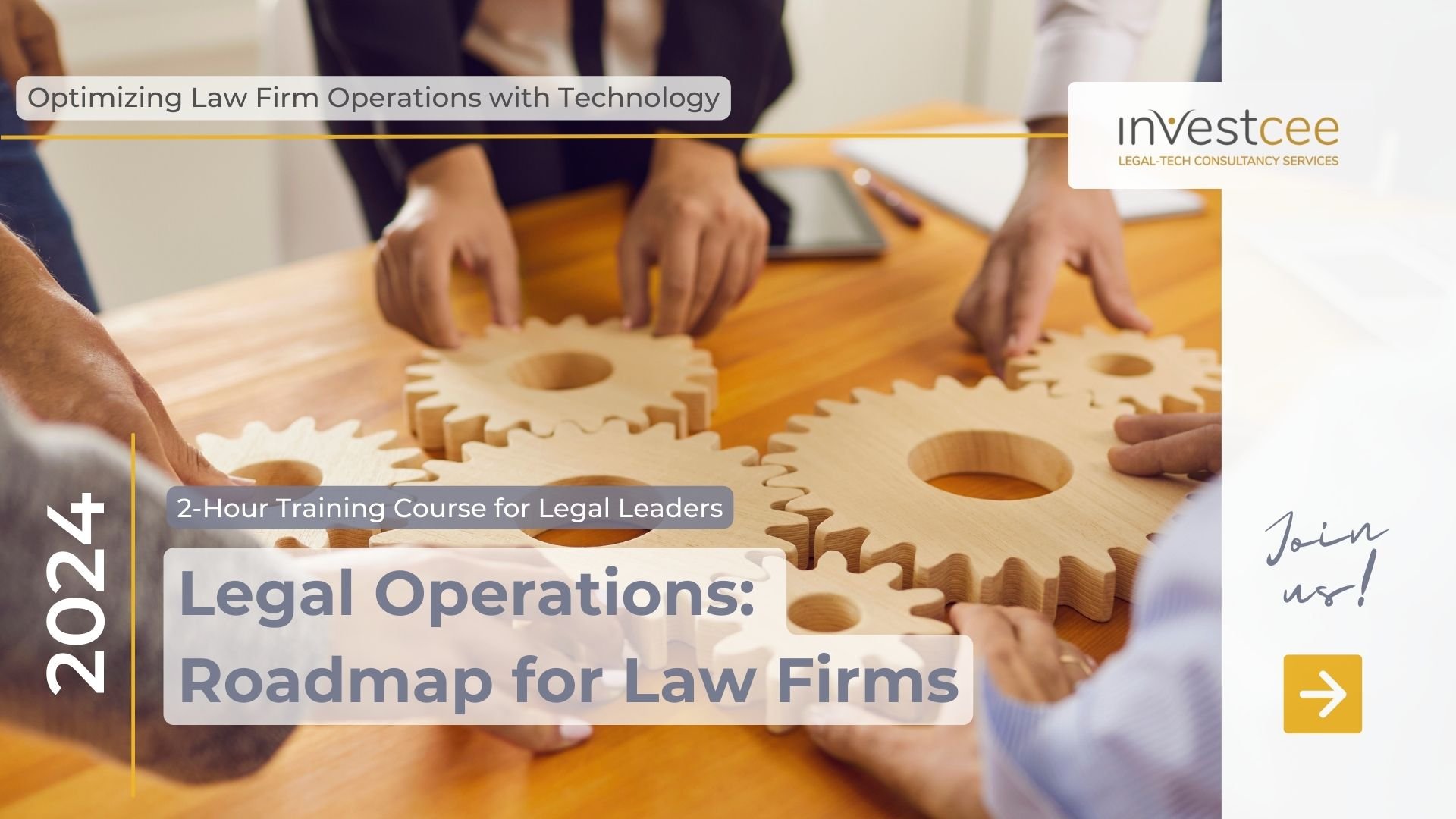What does Legal Operations mean for Law Firms?
Legal operations is what it takes to run a law firm (as a business) on top of practicing law by profession. It includes client management, strategic planning, legal project management, financial oversight, and legal industry expertise. Optimizing law firm operations is all about efficiency and effectiveness: how can the firm best deploy its lawyers and technology resources to advance the clients’ goals, manage legal risks and showcase the added-value created with legal work?
Legal Operations: Roadmap for Law Firms is a training course hosted by InvestCEE LegalTech Consultancy designed to provide strategic guidance to optimizing legal service delivery with technology. This course is dedicated to law firm leaders and decision-makers (owners, partners, operations managers, IT and process leaders).
Your Options to Access the Course Content
1/ Private Course & Custom Demos
The 2-hour online course (with customized demo content) is available as a private training for legal teams of all sizes - please scroll for the agenda (Part A) and demo options (Part B). To sign up, please fill out the registration form below and proceed to payment.
Registration fee: EUR 200 / participant.
2/ Video Content: 45-minute Recording
We have recorded the theoretical part of the full online course (Part A only) and make it available on demand. To access the video recording, please fill out the registration form below and proceed to payment.
Recording purchase price: EUR 80 / user.
3/ Public Webinar: 2-hour Training
We occasionally host public live sessions in 2-hour online course format - please scroll for the full agenda and fill out the registration form below. To get notified about the upcoming webinar dates, please sign-up for our Smarter Legal Newsletter or follow our company LinkedIn page.
Registration fee: EUR 200 / participant.
Register here to access the course content!
Legal Operations: Roadmap for Law Firms
Register now
What can Legal Operations do for my Law Firm?
The goal of legal operations is to optimize law firm performance. Dedicated legal operations projects help law firms to improve client management, collaboration within the team and with clients, choose the right legal technology for optimizing work flow, better identify and manage risks, and enhance work quality.
The good old advice to “run your law firm like a business” is the theory, while legal operations is the practice behind the business of law. While every law firm and jurisdiction is different (and some teams, budgets and regulatory pressures are bigger than others), law firms of all sizes (including solo practitioners) can see real value from implementing legal operations initiatives.
Agenda for the Roadmap Course
The course enables a complex learning experience for law firm leaders. Part A provides strategic guidance for 10 key areas of law firm operations:
- Client intelligence: capturing matter data to make better decisions, optimize firm processes & workflows and focus on understanding clients’ needs.
- Financial management: developing accurate budgets and tracking forecasts throughout the business year to encourage the responsible usage of resources.
- Technology partner management: selecting and onboarding the adequate service providers, establishing fair pricing models for short-term projects (e.g., audit for a client) and long-term operations (e.g., client relationship management, matter workflow, etc).
- Technology tools & automation: identifying manual and/or repetitive legal work processes for optimization via legaltech and automation techniques, to improve both internal efficiency and client-facing legal service.
- Data security & governance: creating policies for sharing and retaining information, managing information security, and ensuring compliance.
- Knowledge management: enabling a law firm culture of sharing information, designing for flexibility in workflows and supporting all team members with shared know-how captured in step-plans and playbooks.
- Collaboration & team management: optimizing legal practice operations by creating a value-driven law firm culture, building on the human skillsets and expertise in the team, and strengthening teams by providing them with adequate tools to perform their work efficiently and collaboratively.
- Workflow management: giving management, lawyers and staff access to accurate, real-time updated database for all matters, opportunities, projects and tasks, to ensure an operating model that matches the type work to the right skillset and resources.
- Innovation & development: designing legal service delivery models that combine traditional legal skills with tech-assisted ways of working, enabling a professional career model for continuing development matched with individual skills and needs.
- Strategic planning: setting short-term objectives and formulating long-term goals to prioritize a law firm agenda aligned with client needs, team goals and legal market developments.
Part B provides hands-on practical demonstration regarding:
➤ Legal practice management (e.g., tracking matters, coordinating tasks, budgeting and planning, etc.)
➤ Document automation techniques (e.g., creating document portals, clause libraries, interactive document templates, etc.)
➤ AI-assisted legal service solutions (e.g., offering contract management, document review, legal data analysis, etc.)
➤ Corporate housekeeping (e.g., managing legal entities, governance tasks, etc.)
Need more information about our course offering? Reach out or take a look at other training courses!

InvestCEE LegalTech Consultancy, 2024
We value your privacy. Read our Legal Statement.
